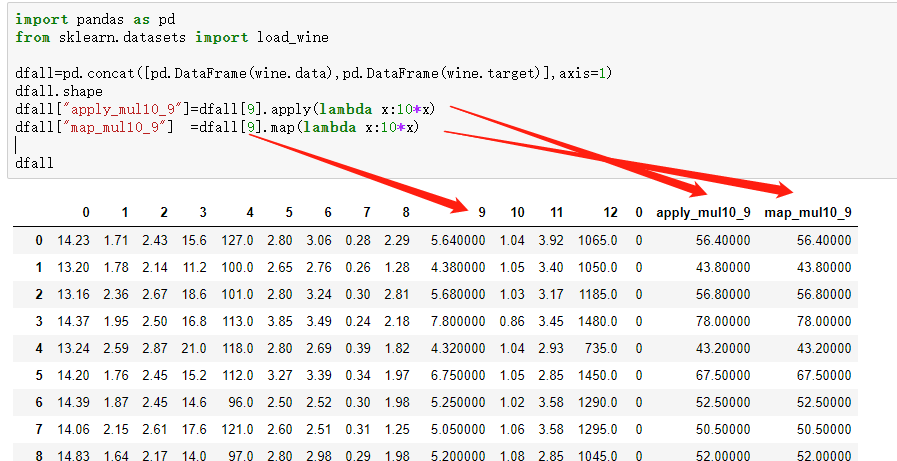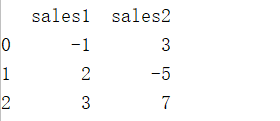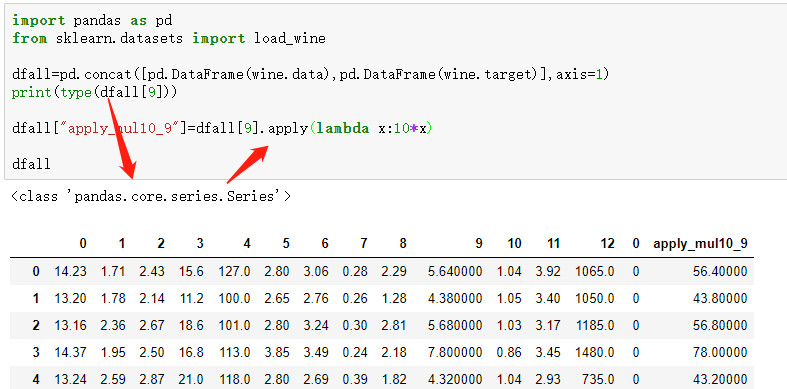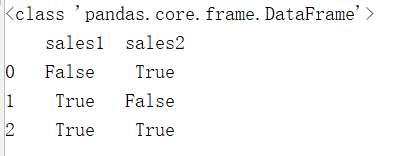python中的apply(),applymap(),map() 的用法和区别
平时在处理df series格式的时候并没有注意 map和apply的差异

总感觉没啥却别。不过还是有区别的。下面总结一下:
- import pandas as pd
- df1= pd.DataFrame({
- "sales1":[-,,],
- "sales2":[,-,],
- })

1.apply
1、当我们要对数据框(DataFrame)的数据进行按行或按列操作时用apply()
note:操作的原子是行和列 ,可以用行列统计描述符 min max mean ......
当axis=0的时候是对“列”进行操作
- df2=df1.apply(lambda x: x.max()-x.min(),axis=0)
- print(type(df2),"\n",df2)

axis=1的时候是对“行”进行操作
- df3=df1.apply(lambda x: x.max()-x.min(),axis=1)
- print(type(df3),"\n",df3)

2.也可以直接选定一列series,或者df直接操作

2.applymap
1.applymap函数之后,自动对DataFrame每一个元素进行处理,判断之后输出结果
- df4=df1.applymap(lambda x: x>0)
- print(type(df4),"\n",df4)

2.applymap是对 DataFrame 进行每个元素的单独操作
ie:不能添加列统计函数,因为是只针对单个元素的操作
- df5=df1.applymap(lambda x: x.min())
- print(type(df5),"\n",df5)

3.'Series' object has no attribute 'applymap'
- df4=df1["sales1"].applymap(lambda x: x>0)
- print(type(df4),"\n",df4)

3.map
1.'DataFrame' object has no attribute 'map'
- df4=df1.map(lambda x: x**2)
- print(type(df4),"\n",df4)

2.map其实是对 列,series 等 进行每个元素的单独操作
ie:不能添加列统计函数,因为是只针对单个元素的操作
- df3=df1["sales1"].map(lambda x: x.max()-x.min())
- print(type(df3),"\n",df3)

3.正常
- df4=df1["sales1"].map(lambda x: x**2)
- print(type(df4),"\n",df4)

python中的apply(),applymap(),map() 的用法和区别的更多相关文章
- python中的filter、map、reduce、apply用法
1. filter 功能: filter的功能是过滤掉序列中不符合函数条件的元素,当序列中要删减的元素可以用某些函数描述时,就应该想起filter函数. 调用: filter(function,seq ...
- apply(), applymap(), map()
Pandas 中map, applymap and apply的区别 https://blog.csdn.net/u010814042/article/details/76401133/ Panda ...
- python中urllib, urllib2,urllib3, httplib,httplib2, request的区别
permike原文python中urllib, urllib2,urllib3, httplib,httplib2, request的区别 若只使用python3.X, 下面可以不看了, 记住有个ur ...
- Java中集合List,Map和Set的区别
Java中集合List,Map和Set的区别 1.List和Set的父接口是Collection,而Map不是 2.List中的元素是有序的,可以重复的 3.Map是Key-Value映射关系,且Ke ...
- python中生成器对象和return 还有循环的区别
python中生成器对象和return 还有循环的区别 在python中存在这么一个关键字yield,这个关键字在项目中经常被用到,比如我写一个函数不想它只返回一次就结束那我们就不能用return,因 ...
- Python中%r和%s的详解及区别_python_脚本之家
Python中%r和%s的详解及区别_python_脚本之家 https://www.jb51.net/article/108589.htm
- python中os.path.abspath与os.path.realpath 区别
python中os.path.abspath与os.path.realpath 区别cd /homemkdir amkdir btouch a/1.txtln -s /home/a/1.txt /ho ...
- 脚本引用中的defer和async的用法和区别
之前的博客漫谈前端优化中的引用资源优化曾经提到过脚本引用异步设置defer.async,没有细说,这里展开一下,谈谈它们的作用和区别,先上张图来个针对没用过的小伙伴有个初始印象: 是的,就是在页面脚本 ...
- 浅谈JS中的!=、== 、!==、===的用法和区别 JS中Null与Undefined的区别 读取XML文件 获取路径的方式 C#中Cookie,Session,Application的用法与区别? c#反射 抽象工厂
浅谈JS中的!=.== .!==.===的用法和区别 var num = 1; var str = '1'; var test = 1; test == num //tr ...
随机推荐
- 【ActiveReports 大数据分析报告】2019国庆旅游出行趋势预测
今年国庆假期全国接待国内游客人数有望达到8亿人次! 随着2019国庆小长假的临近,不少游客已经开始着手规划假期出游路线.据权威机构发布的<2019国庆旅游趋势预测报告>显示,今年“十一黄金 ...
- 什么是时序时空数据库TSDB
时序时空数据库(Time Series & Spatial Temporal Database,简称 TSDB)是一种高性能.低成本.稳定可靠的在线时序时空数据库服务,提供高效读写.高压缩比存 ...
- ssm中静态文件加载路径
项目在本地软件和在服务器上的项目路径如果写死,有可能会出现项目在本机上可以访问,架设在服务器上后就不能访问 这儿介绍在ssm框架中使用 @WebServlet(urlPatterns = {},loa ...
- 【Java学习】类、对象、实例—类是对象的抽象,对象是类的实例
类.对象.实例的关系是什么,如果不能很好的理解什么是类什么是对象就无法讲清楚, 类:某种事物与另一种事物具有相似性,比如哈士奇和泰迪,我们发现他们有一些相似的特性和行为,在生物学上,他们都属于“狗”, ...
- selenium登录豆瓣网
登录流程: 实例化一个driver,然后driver.get()发送请求 最重要的:切换iframe子框架,因为豆瓣的网页中的登录那部分是一个ifrme,必须切换才能寻找到对应元素 利用seleniu ...
- 关于php性能优化
php性能优化 1.尽量静态化: 如果一个方法能被静态,那就声明它为静态的,速度可提高1/4,甚至我测试的时候,这个提高了近三倍. 当然了,这个测试方法需要在十万级以上次执行,效果才明显. 其实静态方 ...
- pip安装源
目录 介绍 永久配置安装源 Windows MacOS.Linux 配置文件内容 介绍 """ 1.采用国内源,加速下载模块的速度 2.常用pip源: -- 豆瓣:htt ...
- B2C电商平台开发心得(asp.net+bootstrap)
Bootstrap,来自 Twitter,是目前最受欢迎的前端框架.Bootstrap 是基于 html.css.javascript的,专为 web 应用设计,包含了移动设备优先的样式, 其响应式 ...
- dev gridview拖拽数据移动
设置属性gridView1.OptionsSelection.EnableAppearanceFocusedCell = false; //确保选定行的背景色一样. private BindingLi ...
- 异常-try...catch的方式处理异常1
package cn.itcast_02; /* * 我们自己如何处理异常呢? * A:try...catch...finally * B:throws 抛出 * * try...catch...fi ...
